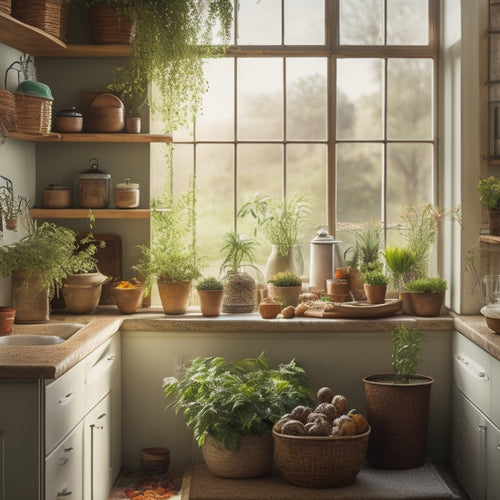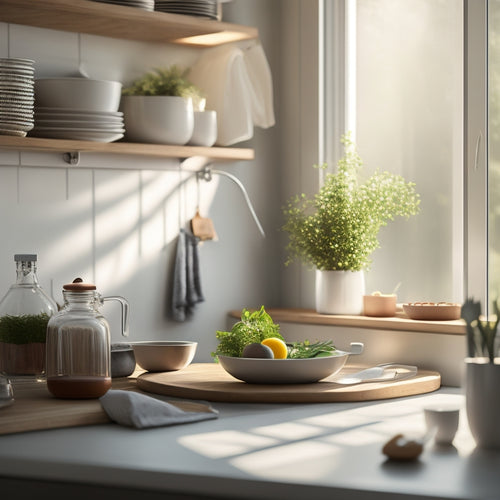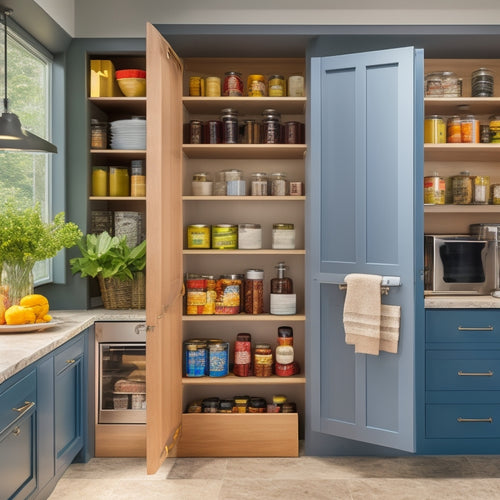
Streamline Your Space: Cookware and Dish Storage Tips
Share
You want to free up space in your kitchen and make meal prep a breeze. Start by maximizing your vertical storage with shelves, hooks, or a pegboard on kitchen walls. Utilize corner areas with carousels, Lazy Susans, or corner shelves, and implement stacking and nesting strategies for compact storage. Designate zones for similar items, and consider hanging pots and pans to optimize storage. With these strategies, you'll be well on your way to a clutter-free kitchen. Now, take the next step to discover more clever storage solutions that'll help you whip up a meal in no time.
Key Takeaways
• Maximize vertical storage space by installing shelves, hooks, or a pegboard on kitchen walls for cookware and dishes.
• Utilize corner areas effectively with carousels, Lazy Susans, or corner shelves to store heavy or bulky items.
• Implement stacking and nesting strategies for compact storage of pots, bowls, and lids to save vertical space.
• Designate zones for items by labeling containers and creating cooking, baking, cleaning, and food prep areas for quick access.
• Hang pots and pans to maximize vertical space, grouping similar items together and considering weight capacity and durability.
Maximizing Vertical Storage Space
By installing shelves, hooks, or a pegboard on your kitchen walls, you can access valuable vertical storage space for your cookware and dishes. This will help keep your countertops clear and make meal prep more efficient. Consider wall-mounted shelves or ceiling hooks to hang items like pots, pans, and utensils, keeping them within easy reach.
Under cabinet hooks can also be used to store items like ladles, spatulas, or even tea towels. For smaller items, magnetic strips can be attached to the side of a cabinet or fridge to store spices, oils, or frequently used condiments. This will keep them organized and visible, making it easier to find what you need when cooking.
Utilizing Corner Areas Effectively
You can also optimize the often-wasted space in corners by installing carousels, Lazy Susans, or corner shelves to store cookware, dishes, and utensils, keeping them easily accessible and organized. This is especially useful for heavy or bulky items that you don't use frequently, like slow cookers or serving platters. By utilizing corner areas effectively, you'll create a more efficient workflow in your kitchen.
Consider installing pull-out drawers or swing-out racks to maximize storage capacity in these often-neglected spaces. This will allow you to store items like pots, pans, and lids, keeping them out of the way but still easily accessible.
You can also use corner shelves to store infrequently used items, like special occasion dishes or cookbooks. By making the most of your corner areas, you'll be able to free up space in other areas of your kitchen, creating a more streamlined and organized cooking environment.
With a little creativity and planning, you can turn these often-wasted spaces into valuable storage areas.
Stacking and Nesting Strategies
To maximize storage capacity and minimize clutter, implement stacking and nesting strategies for your cookware and dishes, allowing them to fit together seamlessly like a puzzle. This approach guarantees compact storage, making the most of your available space. By stacking and nesting, you can efficiently store your cookware and dishes, keeping them organized and within reach.
Here are some stacking and nesting strategies to try:
| Strategy | Benefits | Example |
|---|---|---|
| Nested pots | Saves vertical space, reduces clutter | Store smaller pots inside larger ones |
| Stacked bowls | Maximizes horizontal space, easy access | Stack bowls of similar sizes |
| Interlocking lids | Reduces lid clutter, easy storage | Store lids in a stacked, interlocking manner |
| Collapsible items | Saves space, easy storage | Use collapsible silicone containers or colanders |
| Adjustable dividers | Customizable storage, flexible | Use dividers to separate cookware and dishes |
Designating Zones for Items
Now that you've optimized your storage space with stacking and nesting strategies, designate zones for items to maintain organization and make meal prep a breeze. This means assigning specific areas for similar items, making it easy to find what you need when you need it. By doing so, you'll reduce clutter and increase productivity in the kitchen.
Here are some tips to help you designate zones effectively:
-
Labeling containers: Use labels or stickers to identify what's inside containers, so you can quickly grab what you need.
-
Create a cooking zone near the stove or cooktop, storing frequently used cookware and utensils within easy reach.
-
Designate a baking zone near the oven, storing baking sheets, pans, and utensils.
-
Set up a cleaning zone near the sink, storing cleaning supplies and dishwashing essentials.
-
Establish a food prep zone on a countertop or island, storing cutting boards, knives, and other prep tools.
Hanging Pots and Pans
Maximizing your kitchen's vertical space by hanging pots and pans not only maintains them organized but also frees up valuable storage space in your cabinets and on countertops.
You can install wall hooks or ceiling racks to create a space-saving solution that adds to your kitchen decor. This will allow you to easily access your cookware while keeping them out of the way.
Consider grouping similar items together, such as hanging all your frying pans on one rack and your saucepans on another. This will make it easier to find what you need when you need it.
When choosing a hanging system, think about the weight capacity and durability of the hooks or racks. You'll also want to confirm they're easy to clean and resistant to rust or corrosion.
Optimal Cabinet Organization
With your pots and pans neatly organized on the walls, you can turn your attention to optimizing the storage space inside your cabinets, where you'll likely store smaller cookware, dishware, and kitchen utensils. This is a pivotal step in streamlining your kitchen, as cluttered cabinets can lead to wasted time and energy.
To maximize your cabinet space, consider the following:
-
Install under shelf hooks to hang items like colanders, utensils, or even a dish rack, freeing up shelf space.
-
Use magnetic knife strips to store knives and other metal utensils, keeping them organized and within reach.
-
Invest in adjustable shelf risers to customize the height of your shelves and create more storage opportunities.
-
Add wire basket inserts to store small items like spices, oils, or condiments, keeping them visible and accessible.
-
Consider a lazy Susan in a corner cabinet to make the most of that often-overlooked space.
Drawer Dividers and Inserts
You can further streamline your kitchen by tackling the often-chaotic world of drawers, where a jumbled mess of utensils, cookware, and gadgets can quickly get out of hand.
To bring order to this chaos, consider using drawer dividers and inserts to separate and categorize your kitchen essentials. These clever storage solutions will help you make the most of your drawer space, keeping frequently used items within easy reach while keeping less-used items tucked away.
Shelf organizers and compartment trays can be used to separate cookware, utensils, and gadgets, while drawer separators can be used to create distinct zones within your drawers. This will prevent clutter from building up and make cleaning a breeze.
Additionally, cabinet racks can be installed to maximize vertical storage, further reducing clutter and increasing efficiency. By implementing these storage solutions, you'll be able to find what you need quickly and easily, making meal prep and cooking a more enjoyable experience for you and those you're serving.
Creative Use of Backsplash
Once your drawers are organized, turn your attention to the often-underutilized space behind your cooktop or countertop, where a creative use of backsplash can add visual appeal, protect your walls, and even provide additional storage.
A well-designed backsplash can be both functional decor and a stylish solution to your storage needs.
Here are some ideas to get you started:
- Use colorful tiles to create a visually appealing backsplash that adds personality to your kitchen.
- Install a pegboard behind your cooktop to hang frequently used utensils and spices, keeping them within easy reach.
- Add a hidden storage compartment behind a decorative tile or cabinet to stash away infrequently used items.
- Incorporate a shelf or ledge to display decorative items or store cookbooks.
- Consider a magnetic backsplash to store metal spices, oils, or utensils, keeping them organized and out of the way.
Frequently Asked Questions
How Do I Prevent Water Spots on My Stored Dishes?
To prevent water spots on your stored dishes, you'll want to dry them thoroughly before putting them away, and consider using a dish rack with a built-in water catcher or a microfiber cloth to absorb excess moisture.
Can I Store Cookware With Wooden or Silicone Handles?
You can store cookware with wooden or silicone handles, but consider hanging options or shelf organization with dividers to prevent scratching and damage, ensuring your cookware remains in great condition for serving others.
Are Ceramic or Glass Storage Containers Better for Cookware?
When choosing between ceramic or glass storage containers for your cookware, you'll want to weigh metal vs plastic lids and size factors, ensuring a secure, space-efficient fit that protects your cookware and makes serving others a breeze.
How Often Should I Clean My Cookware Storage Areas?
Diligent daily duties demand dust-free domains! You should clean your cookware storage areas every 1-2 weeks, or more frequently if you notice buildup, to maintain hygiene maintenance and guarantee a clean cooking environment.
Can I Store Sharp Knives in a Drawer Organizer?
You can store sharp knives in a drawer organizer, but prioritize knife safety by choosing a divider with individual slots, ensuring easy access and efficient use of drawer space while maintaining organization.
Related Posts
-

Tiered Kitchen Rack Ideas for Small Spaces
Tiered kitchen racks are perfect for maximizing small spaces while adding style and functionality. Install wall-mount...
-

Space-Efficient Dish Racks for Tiny Homes
Space-efficient dish racks are a game changer for tiny homes. By utilizing vertical storage, you can free up signific...
-

Affordable Sliding Pantry Drawer Solutions
If you're looking for affordable sliding pantry drawer solutions, you're in the right place. These drawers maximize s...


